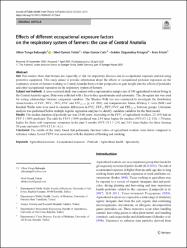| dc.contributor.author | Babaoğlu, Ülken Tunga | |
| dc.contributor.author | Oymak Yalçın, Sibel | |
| dc.contributor.author | Çalış, Aliye Gamze | |
| dc.contributor.author | Özgünaltay Ertuğrul, Gülden | |
| dc.contributor.author | Ertürk, Arzu | |
| dc.date.accessioned | 2025-02-07T08:34:03Z | |
| dc.date.available | 2025-02-07T08:34:03Z | |
| dc.date.issued | 2022 | en_US |
| dc.identifier.citation | Babaoglu, U. T., Oymak Yalcin, S., Calis, A. G., Ozgunaltay Ertugrul, G., & Erturk, A. (2021). Effects of different occupational exposure factors on the respiratory system of farmers: the case of Central Anatolia. Journal of Public Health, 1-9. | en_US |
| dc.identifier.issn | 21981833 | |
| dc.identifier.uri | https://10.1007/s10389-021-01554-6 | |
| dc.identifier.uri | https://hdl.handle.net/20.500.12513/7077 | |
| dc.description.abstract | Aim: Past studies show that farmers are especially at risk for respiratory diseases due to occupational exposure and not using protective equipment. This study aimed to provide information about the effects of occupational pesticide exposures on the respiratory system of farmers working in Central Anatolia from a wider perspective to gain insight into the effects of pesticides and other occupational exposures on the respiratory system of farmers. Subject and methods: A cross-sectional study was conduct with a representative sample size of 380 agricultural workers living in the Central Anatolia region. Data were collected with a face-to-face questionnaire and spirometry. The chi-square test was used for testing relationships between categorical variables. The Shapiro–Wilk test was conducted to investigate the distribution characteristics of FVC, FEV1, FEV1/FVC and FEF25–75 (p > 0.050), and nonparametric Mann–Whitney U tests (MW) and Kruskal–Wallis tests were used to examine differences in FVC, FEV1, FEV1/FVC and FEF25–75 between groups. Univariate analysis was performed before multiple logistic regression analyses to identify candidate variables for the final model. Results: The median duration of pesticide use was 25.00 years. According to the FEV1 of agricultural workers, 23.16% had an FEV 1 ≤ 80% predicted. The odds for FEV1 ≤ 80% predicted was 2.44 times higher for smokers (95% CI 1.2–5.0), 1.74 times higher for those with respiratory symptoms in the past 3 months (95% CI 1.1–2.9) and 5.01 times higher for those farming 30 years and more (95% CI 1.8–14.1). Conclusion: The results of the study found that pulmonary function values of agricultural workers were lower compared to reference values. Lower FEV1 was associated with the duration of farming and smoking. © 2021, The Author(s), under exclusive licence to Springer-Verlag GmbH Germany, part of Springer Nature. | en_US |
| dc.language.iso | eng | en_US |
| dc.publisher | Springer Nature | en_US |
| dc.relation.isversionof | 10.1007/s10389-021-01554-6 | en_US |
| dc.rights | info:eu-repo/semantics/openAccess | en_US |
| dc.subject | Agricultural Health | en_US |
| dc.subject | Agricultural Workers | en_US |
| dc.subject | Occupational Exposure | en_US |
| dc.subject | Pesticide | en_US |
| dc.subject | Spirometry | en_US |
| dc.title | Effects of Different Occupational Exposure Factors on The Respiratory System of Farmers: The Case of Central Anatolia | en_US |
| dc.type | article | en_US |
| dc.relation.journal | Journal of Public Health (Germany) | en_US |
| dc.contributor.department | Tıp Fakültesi | en_US |
| dc.identifier.volume | 30 | en_US |
| dc.identifier.issue | 9 | en_US |
| dc.identifier.startpage | 2123 | en_US |
| dc.identifier.endpage | 2131 | en_US |
| dc.relation.publicationcategory | Makale - Uluslararası Hakemli Dergi - Kurum Öğretim Elemanı | en_US |


















